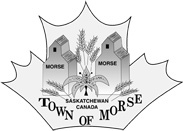
Town of Morse

About us
Located is Southern Saskatchewan on the Highway 1, the Town of Morse is centrally located 45 minutes from the City of Swift Current and approximately an hour from the City of Moose Jaw. The Town of Morse provides support and services to the agriculture industry surrounding the community.
History of Morse
The Beginning of Morse
Morse got its start in 1896 when the first residents (railway employees) came to what would become the townsite. The first structures to be built were a fourteen square foot railway station, a windmill, a water tank, and a section house for the employees. At this time there was no settlers between Morse and the South Saskatchewan River or south to the American border. In the spring of 1902, a large number of men arrived in the area in order to conduct work on the rail line. Work such as cutting down the grades and straightening the railway. It was around this time that a couple of houses and a lumber yard were established on the southern side of the tracks.
That same year, the C.P.R staked out what is now the townsite, the section located to the north of the tracks. The townsite sits upon Section 9, Township 17, Range 8, West of the 3rd Meridian. This had been a section of land that had been granted to the C.P.R by the Dominion Government. The burgeoning hamlet was named in honour of the C.P. R’s Western Superintendent at the time, a man whose name was Morse. The first individuals to settle at Morse were brothers J.P. and George McKenzie and a man named Ben McGregor. Four years later in 1906 the main rush of homesteaders would come to the Morse area. Over the course of 1906 and 1907, settlers poured into the area and by 1909 most of the good homesteading land had been taken.
In 1908 the government constructed a road across Reed Lake. It was this road that was the making of Morse, as prior to this road being constructed, those who lived south of Reed Lake went to Herbert instead of Morse. That same year, the first school was established. This school was located in a small shack and Miss McRea was given the job as the teacher. Prior to the establishment of the school, children were educated in a room at the C.P.R station. As of 1908 Morse’s population sat at fifty people and grew by another fifty the following year.
It was in 1910 that Morse progressed from a hamlet to a village and George A. McKenzie, one of the first settlers, was installed as overseer. The population continued to grow as it reached 650 in 1912. With the increase in population, Morse thus became a town (1 November 1912) and Jesse James Williams was elected the first Mayor. It was at this time Morse was in its heyday. The town was a major grain hub as it was the third largest grain marketing point in the province. 1.5 million bushels of wheat were delivered to the elevators and grain buyers that year. By 1913 Morse had hit its peak population of approximately 900 people.
During its height, the town of Morse was home to many businesses and had many amenities. This included five grain elevators, six lumber yards, two banks, seven general stores, two confectioneries, two drug stores, two hotels, four restaurants, two harness shops, three hardware stores, two pool rooms, two barbershops, a photo studio, a gentleman’s furnishings store, two blacksmiths shops, an auto garage, a cobbler, five implement dealers, two auto agencies, a livery, four feed and sales stables, a jeweller, a baker, two ice cream parlours, two butcher shops, two chopping mills, two oil warehouses, three coal dealers, a shooting gallery, a newspaper, and two draying businesses. In 1928 the thriving town would get a detachment of RCMP, something that remains a staple in the community today.
- John C Griffin, Morse Museum Curator